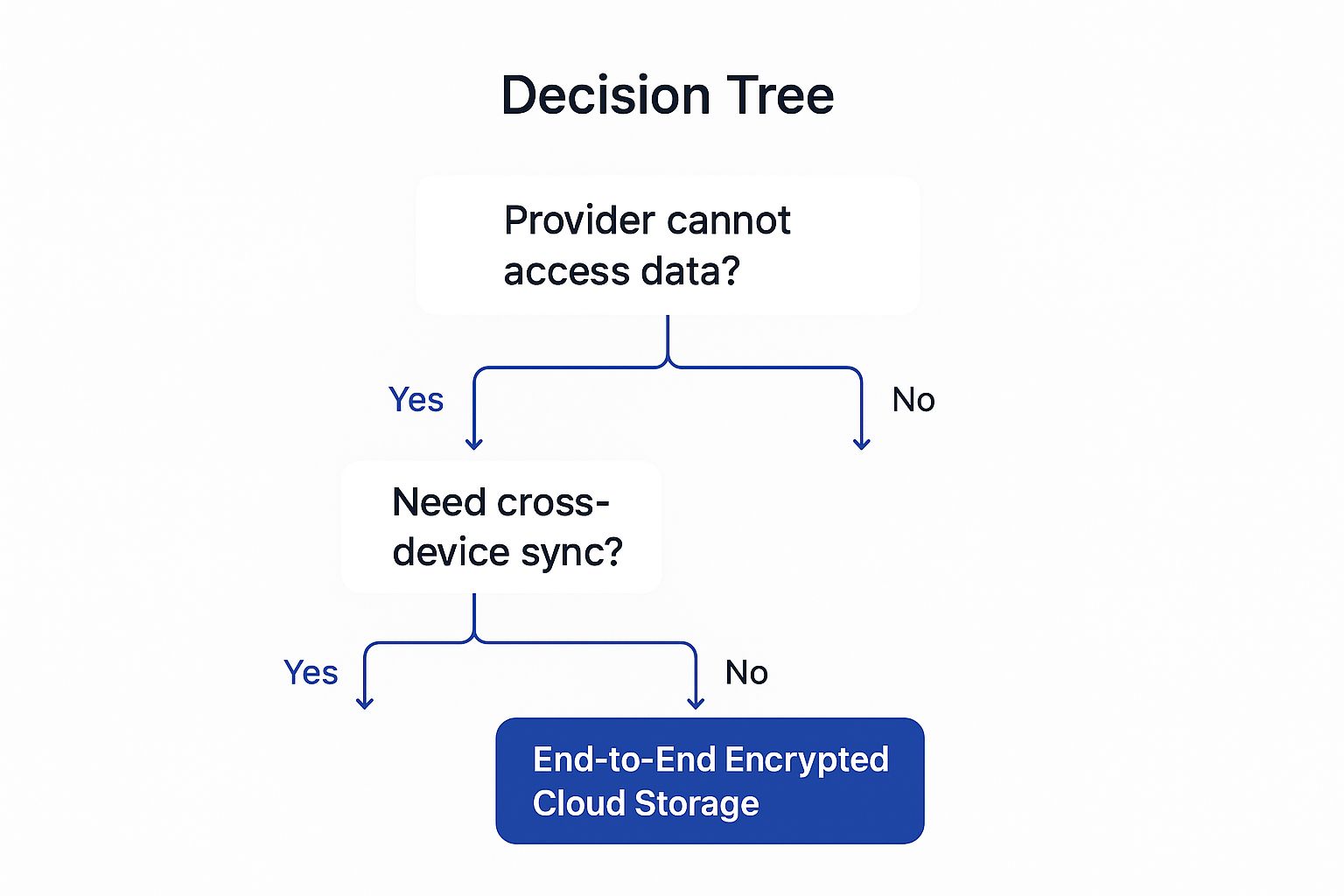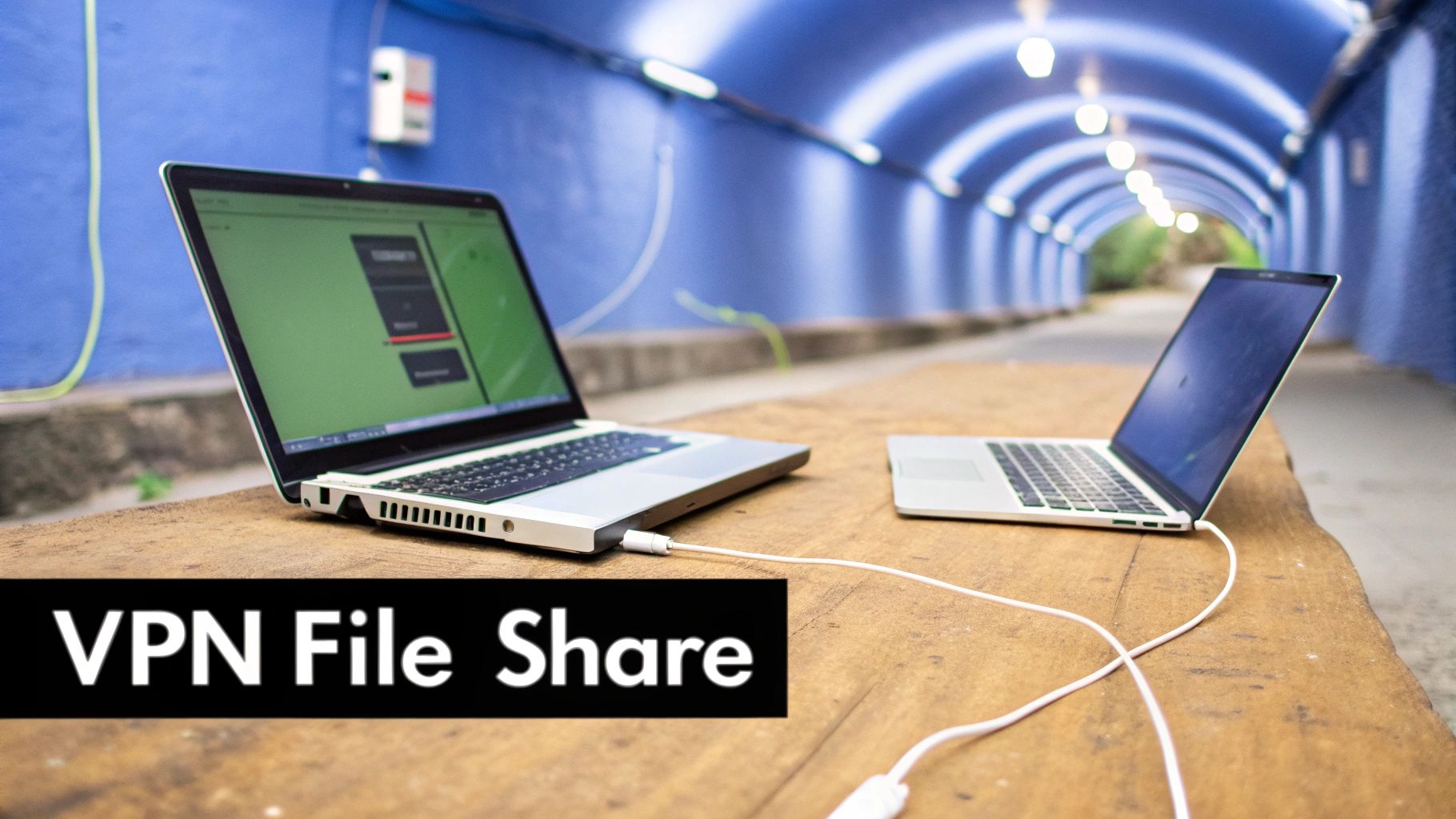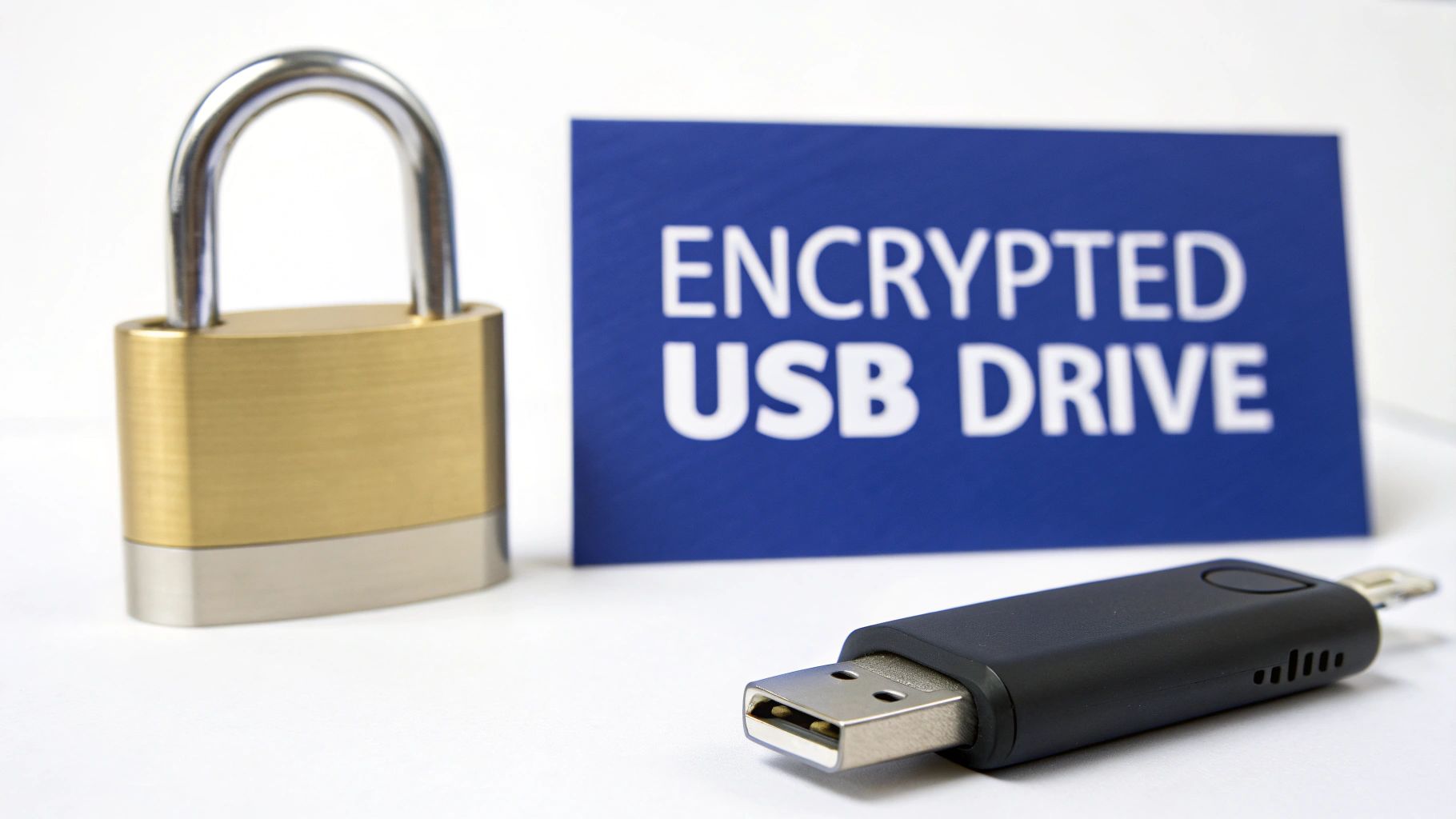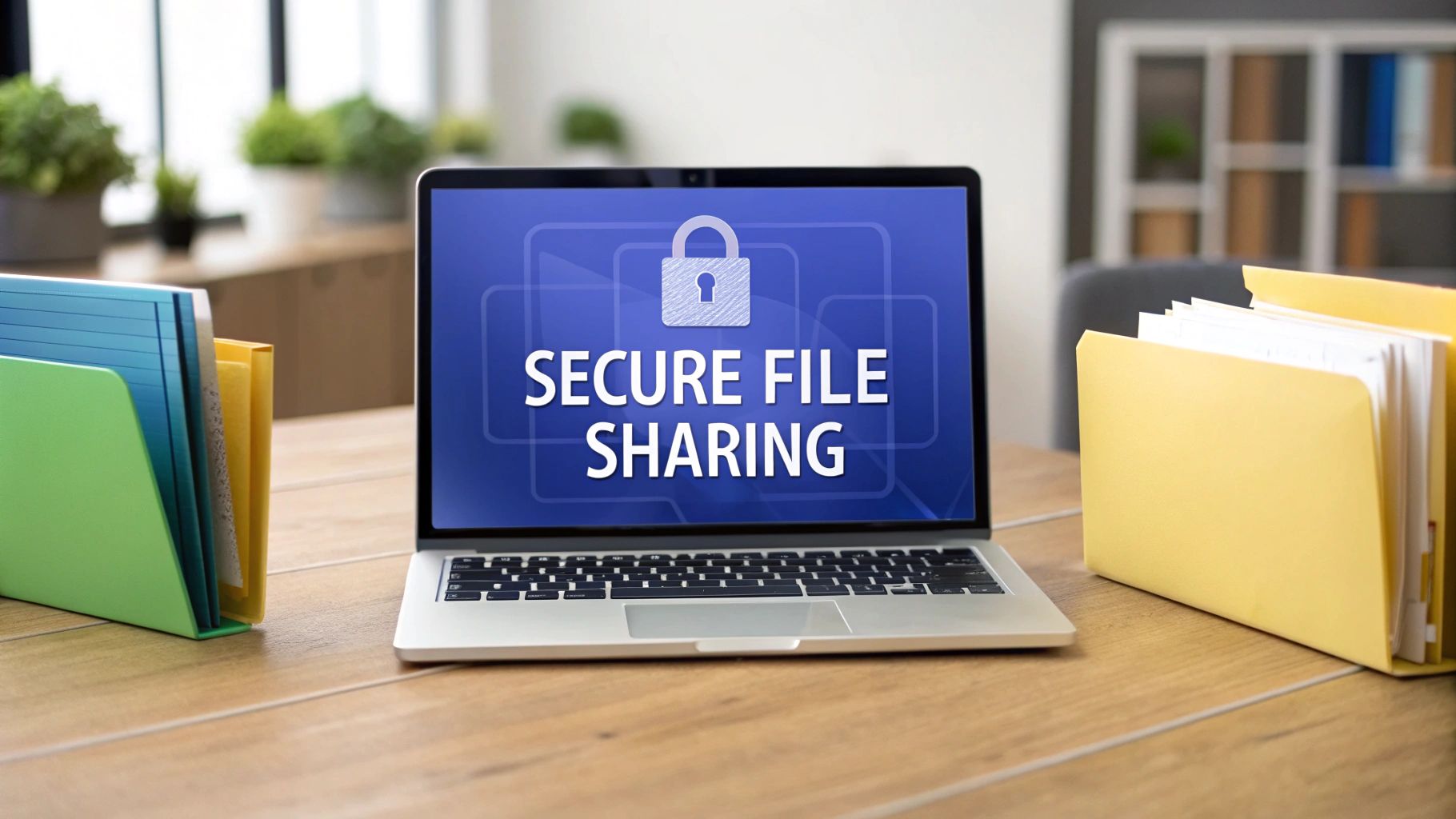Sharing Files Securely: No More Headaches
Sharing files is essential for collaboration, but security breaches can be devastating. This listicle reveals the 7 best ways to share files securely in 2025. Learn how to protect your confidential data—from client information to project files—with solutions ranging from simple cloud storage to advanced encryption methods. Discover the best way to share files securely for your specific needs and eliminate security worries. We'll cover end-to-end encrypted cloud storage, SFTP, PGP encryption, VPNs, self-hosting options, secure portable devices, and secure messaging platforms.
1. End-to-End Encrypted Cloud Storage
When seeking the best way to share files securely, end-to-end encrypted (E2EE) cloud storage stands out as a leading solution. This method ensures your files are encrypted on your device before they're uploaded to the cloud. They remain in this encrypted state until they're downloaded and decrypted by the intended recipient. Crucially, this means that even the cloud storage provider cannot access your unencrypted data, offering robust protection against data breaches and unauthorized access. This approach prioritizes privacy and gives you ultimate control over your sensitive information.

The infographic above presents a decision tree to guide you in assessing your file-sharing security needs. Starting with the question of whether file confidentiality is paramount, the flowchart leads you through considerations like data sensitivity, compliance requirements, and the technical capabilities of your recipients. This helps you determine if E2EE is the right solution or if alternative methods like password protection might suffice. As the infographic illustrates, E2EE emerges as the optimal choice when dealing with highly sensitive information requiring the utmost protection.
Services employing zero-knowledge encryption architecture are particularly advantageous. This ensures that only you and your intended recipients hold the decryption keys. Many E2EE services enhance security further with features like secure file-sharing links, password protection, and automatic synchronization across your devices. This allows for seamless access to your secured files from any location while maintaining the highest levels of confidentiality.
Learn more about End-to-End Encrypted Cloud Storage
This approach offers significant advantages: strong security against data breaches, even if the service provider is compromised; ease of use thanks to modern interfaces; and accessibility from multiple devices. Providers like Tresorit, ProtonDrive (by the makers of ProtonMail), Sync.com, and pCloud Crypto exemplify successful implementations of E2EE, offering varying features and pricing tiers. For robust security when sharing sensitive files, consider platforms specializing in secure document exchange, such as Attachdoc, which offer features like end-to-end encryption and granular access controls. More information on secure document sharing best practices can be found here: secure sharing of documents.
However, E2EE is not without its drawbacks. Lost encryption keys can mean permanently losing access to your data. These services are often more expensive than non-encrypted alternatives and may have performance limitations due to encryption overhead. Content preview capabilities are often limited for shared files, and some services impose file size or storage capacity restrictions.
To maximize your security when using E2EE cloud storage, consider these tips: enable two-factor authentication, set expiration dates on shared links, use strong and unique passwords, regularly audit shared file access, and compartmentalize sensitive data into different encrypted folders.
E2EE cloud storage is ideal for individuals and teams – from product managers and developers to marketing agencies and content creators – who prioritize the secure sharing of sensitive information. If confidentiality is non-negotiable and you're willing to invest in robust security, E2EE is undoubtedly the best way to share files securely.
2. Secure File Transfer Protocol (SFTP)
When exploring the best way to share files securely, Secure File Transfer Protocol (SFTP) emerges as a robust and reliable solution, particularly for those prioritizing confidentiality and integrity. SFTP (SSH File Transfer Protocol) isn't just another file transfer method; it's a network protocol engineered to provide secure file access, transfer, and management over a reliable data stream. Unlike its less secure predecessor, FTP, SFTP encrypts both commands and data, safeguarding your passwords and sensitive information from prying eyes during transmission. This makes it an ideal choice for product teams, developers, marketing agencies, and anyone handling confidential data.
How Does SFTP Enhance Security?
SFTP leverages the power of the Secure Shell (SSH) protocol, typically operating on port 22. This underlying SSH connection provides the backbone for encrypted authentication and data transfer. Think of it as a secure tunnel through which your files travel, protected from interception. Key features like public key authentication and built-in integrity checking further bolster its security posture. Furthermore, SFTP allows for resuming interrupted transfers, a significant advantage when dealing with large files or unreliable network conditions.
Why Choose SFTP for Secure File Sharing?
SFTP offers a compelling blend of security, reliability, and control:
- Strong Encryption: Both authentication and data transfer are encrypted, shielding your information from unauthorized access.
- Wide Support: SFTP is supported across virtually all operating systems and devices, making it a universally accessible solution.
- Automation Capabilities: Streamline your workflows by automating scheduled transfers, eliminating manual intervention.
- High-Volume Transfers: SFTP excels in handling regular, high-volume transfers, making it suitable for demanding environments.
- Detailed Logging & Confirmation: Maintain comprehensive audit trails with detailed logs and transfer confirmations.
Weighing the Pros and Cons:
While SFTP offers robust security, it's essential to consider its potential drawbacks:
Pros:
- Strong encryption for authentication and data transfer
- Wide platform support
- Automation capabilities
- Suitable for high-volume transfers
- Detailed logging and confirmations
Cons:
- Requires technical expertise for setup and maintenance
- Needs server infrastructure
- Less user-friendly than cloud storage solutions
- Complex firewall configurations
- Regular security updates and maintenance required
Real-World Applications:
SFTP's robust security makes it the preferred choice across various industries:
- Financial Institutions: Secure customer data transfers
- Healthcare Organizations: HIPAA-compliant file transfers
- Government Agencies: Secure document exchanges
- Software Development Teams: Secure code deployment
Actionable Tips for Secure SFTP Implementation:
Maximize your security by following these best practices:
- Key-Based Authentication: Prioritize key-based authentication over passwords for enhanced security.
- File Permissions: Configure strict file permissions on the server to control access.
- Limited User Access: Restrict user access to only necessary directories.
- Chroot Jails: Isolate users within specific directories to prevent unauthorized access to other parts of the system.
- Regular Log Audits: Monitor SFTP server logs for any suspicious activity.
- Software Updates: Keep your SSH/SFTP software updated with the latest security patches.
SFTP's Place Among the Best:
SFTP earns its place as a top secure file sharing method because it delivers uncompromising security without sacrificing reliability and control. It's a proven solution for businesses and individuals who demand the highest level of protection for their sensitive data.
Key Players & Tools:
SFTP's prominence is driven by robust implementations like OpenSSH, popular clients like FileZilla and WinSCP (for Windows), and the vision of SSH protocol creator Tatu Ylönen. Enterprise-grade solutions like GoAnywhere MFT and Cerberus FTP Server further extend SFTP's capabilities. Choosing SFTP is choosing a time-tested, industry-standard method for secure file sharing.
3. PGP Encrypted Email Attachments
When seeking the best way to share files securely, especially sensitive information, PGP encrypted email attachments offer an incredibly robust solution. Pretty Good Privacy (PGP) is an encryption program that provides cryptographic privacy and authentication for data communication. It works by encrypting files before they are attached to emails, ensuring that only the intended recipient with the correct private key can decrypt and access the content. This method leverages public key cryptography, meaning you have a public key to share and a private key to keep secret. You encrypt files using the recipient's public key, and they decrypt them with their corresponding private key. This establishes a secure channel directly between you and the recipient.

PGP isn't just about encryption; it also offers digital signatures. This feature verifies the sender's authenticity, assuring the recipient that the file truly came from you and hasn't been tampered with. Imagine the peace of mind this provides for product teams sharing confidential prototypes, legal firms transferring sensitive client documents, or course creators distributing premium content.
Why PGP deserves a spot on the "best way to share files securely" list: Its robust encryption has stood the test of time, offering a high level of security against unauthorized access. Unlike some secure file-sharing services, PGP has no file size limitations (other than those imposed by your email provider). It seamlessly integrates with existing email systems, meaning no new platforms for your team to learn or manage. Crucially, the recipient doesn't need to create an account on a third-party service, simplifying the process and minimizing potential vulnerabilities.
Features and Benefits:
- Strong Encryption: Provides military-grade encryption for maximum security.
- Digital Signatures: Verifies sender identity and data integrity.
- Email Integration: Works with your existing email client.
- Cross-Platform Compatibility: Use it on Windows, macOS, Linux, and mobile.
- No File Size Limits (beyond email limits): Share large files securely.
- Free and Open-Source Options: Leverage powerful tools like GnuPG without licensing costs.
- Recipient Doesn't Need an Account: Streamlined sharing process.
Pros:
- Very strong encryption proven over decades.
- No inherent file size limitations.
- Works with existing email infrastructure.
- Free and open-source implementations are readily available.
- No third-party account required for recipients.
Cons:
- Key management can be challenging for non-technical users.
- Requires recipients to have PGP setup beforehand.
- Key verification can be cumbersome.
- Not integrated into most standard email clients by default.
- Risk of data loss if private keys are lost.
Examples of Successful Implementation:
- Journalists protecting sensitive communications with sources.
- Organizations encrypting internal documents before sharing.
- Legal firms securing client documents for email transfer.
- Security researchers sharing vulnerability information.
Actionable Tips for Using PGP:
- Key Management: Use a reputable key management tool to simplify handling your keys.
- Verification: Verify recipients' public keys through a secure channel (e.g., in person, over a verified phone call).
- Revocation Certificate: Create a key revocation certificate in case your private key is compromised.
- Backups: Regularly back up your private keys in secure, offline locations.
- PGP-Integrated Clients: Consider using email clients like Thunderbird with Enigmail or browser extensions like Mailvelope for easier integration.
For product teams, individual creators, marketing agencies, developers, and anyone handling sensitive data, PGP encryption offers a powerful and reliable method for ensuring secure file sharing. While it requires some initial setup and understanding of key management, the level of security it provides is unparalleled, making it a worthwhile investment for those prioritizing data confidentiality and integrity.
4. Virtual Private Networks (VPNs) with Shared Folders
When seeking the best way to share files securely, especially for sensitive data, Virtual Private Networks (VPNs) combined with shared folders offer a robust and versatile solution. This method establishes a private, encrypted tunnel across the internet, effectively isolating your file sharing activities from the public domain. Think of it as creating your own secure digital highway for your data, bypassing the risks of the open internet. This is ideal for teams collaborating on confidential projects, transferring large files, or simply needing an extra layer of security for their shared data.

VPNs with shared folders work by first establishing an encrypted connection between all devices on the network. This means every file transferred within this network is encrypted, protecting it from prying eyes. Once the VPN is established, you can create shared folders accessible only to authorized users within the VPN. This allows for seamless collaboration using standard file-sharing protocols like SMB or NFS, just as if everyone were on the same local network. Whether team members are in remote offices, working from home, or scattered across the globe, the VPN ensures secure and efficient access to shared files. This approach bypasses the need for insecure file transfer methods like email attachments, providing a centralized and protected repository for your critical data.
For example, architectural firms can leverage VPNs to share massive CAD files between offices without compromising their intellectual property. Film production companies can securely share video files with remote editors, ensuring confidentiality during post-production. International businesses can maintain secure document repositories accessible to authorized personnel worldwide, facilitating smooth operations and compliance. Software development teams, particularly those working with sensitive codebases, can utilize VPN-protected repositories for version control and asset sharing.
Here are some actionable tips for implementing VPNs with shared folders:
- Implement robust access controls: Restrict access to shared folders based on user roles and responsibilities. This principle of least privilege limits potential damage from unauthorized access.
- Use multi-factor authentication (MFA) for VPN access: Adding an extra layer of security like MFA significantly strengthens your defense against unauthorized logins.
- Regularly audit VPN logs and access records: Proactive monitoring allows you to identify and address any suspicious activity promptly.
- Consider split tunneling to improve performance: Route only sensitive traffic through the VPN, leaving non-sensitive traffic to travel directly to the internet, optimizing speed and bandwidth.
- Use modern VPN protocols like WireGuard or OpenVPN: These protocols offer enhanced security and performance compared to older alternatives.
- Test backup and recovery procedures for shared data: Ensure you have a robust backup and recovery plan in place to protect against data loss.
Pros:
- Creates a secure private network across geographical locations
- Allows the use of familiar file-sharing mechanisms
- No file size limitations other than storage capacity
- Provides additional security beyond just file transfers
- One-time setup for ongoing secure access
Cons:
- Requires technical expertise to set up properly
- Performance can be affected by VPN speed and latency
- Needs proper access controls to prevent unauthorized access
- May require significant infrastructure investment
- Ongoing maintenance and security updates needed
VPNs with shared folders deserve a top spot on the list of best ways to share files securely because they offer a powerful combination of security, flexibility, and control. By creating a private, encrypted environment, this approach ensures your sensitive data remains protected while facilitating seamless collaboration. Popularized by industry leaders like Cisco, OpenVPN, WireGuard, Microsoft, and Palo Alto Networks, this method is a proven and trusted solution for businesses and individuals seeking the best way to share files securely.
5. Self-Hosted File Sharing Solutions
For ultimate control and security when sharing files, self-hosted solutions stand out as the best way to share files securely, especially for organizations with stringent data privacy requirements. This approach involves installing file sharing software, like NextCloud or OwnCloud, directly onto your own servers or infrastructure. By eliminating reliance on third-party providers, you gain complete authority over your data's security, access policies, and storage location. This is paramount for sensitive information and crucial for complying with industry regulations.
How it Works:
Self-hosting empowers you to create a customized file sharing ecosystem tailored to your specific needs. You choose the hardware, the software, and every aspect of the security implementation. This includes setting granular access controls, defining user permissions, and implementing robust authentication methods. The data remains within your own infrastructure, shielded from external access and potential vulnerabilities associated with third-party platforms. Furthermore, most self-hosted solutions offer audit logging and compliance features, allowing you to track file access and ensure adherence to regulatory requirements.
Examples of Successful Implementation:
The flexibility and security of self-hosted file sharing have made it the preferred choice for organizations across various sectors dealing with sensitive data:
- Healthcare: Healthcare organizations leverage platforms like NextCloud for HIPAA-compliant file sharing, ensuring patient data remains confidential and secure.
- Education: Universities deploy OwnCloud to facilitate secure academic collaboration among faculty and students while maintaining control over intellectual property.
- Legal: Law firms utilize Seafile for confidential document sharing, protecting sensitive client information and adhering to strict legal regulations.
- Finance: Financial institutions implement FileRun for secure document storage and sharing, safeguarding critical financial records and ensuring compliance.
Actionable Tips for Secure Self-Hosting:
Implementing a self-hosted solution effectively requires careful planning and ongoing maintenance. Here are some essential tips to ensure the best way to share files securely is truly secure:
- Regular Audits & Penetration Testing: Conduct routine security audits and penetration testing to identify and address vulnerabilities proactively.
- Backups & Disaster Recovery: Implement automated backups and a comprehensive disaster recovery plan to protect against data loss.
- Software Updates: Keep the server software updated with the latest security patches to mitigate known vulnerabilities.
- HTTPS & Valid Certificates: Enforce HTTPS with valid SSL certificates for all connections to encrypt data in transit.
- Strong Passwords & MFA: Implement strong password policies and multi-factor authentication to enhance access security.
- Geo-Redundancy: Consider geo-redundant deployments for critical data to ensure availability even in the event of a regional outage.
Pros and Cons:
| Pros | Cons |
|---|---|
| Maximum control over data security and privacy | Requires significant technical expertise |
| No dependency on third-party service availability | Organization bears full responsibility for security |
| Meets specific compliance requirements | Upfront costs for hardware and software |
| Cost-effective for large-scale deployments | Needs reliable infrastructure for 24/7 availability |
| No data caps or monthly subscription fees | May require dedicated IT staff |
Popular Solutions:
- NextCloud: nextcloud.com (A fork of OwnCloud with enhanced features)
- OwnCloud: owncloud.com (A pioneering self-hosted solution)
- Seafile: seafile.com (Focuses on performance and reliability)
- FileRun: filerun.com (A lightweight alternative)
- Pydio Cells: pydio.com/en/ (A modern, API-centric approach)
Why Choose Self-Hosting?
Self-hosted file sharing is ideal for organizations that prioritize data security and control above all else. If you handle sensitive information, require granular control over access permissions, or need to comply with specific industry regulations, self-hosting offers the best way to share files securely while tailoring the system to your exact requirements. While it requires a greater technical investment upfront, the long-term benefits of enhanced security and control make it a worthwhile investment for organizations that value data privacy and autonomy.
6. Secure Portable Devices and Physical Transfer
When it comes to sharing sensitive files securely, especially when dealing with the best way to share files securely, sometimes the most effective approach is the most traditional. Despite the prevalence of cloud storage and online file transfer services, physically transferring encrypted data via portable devices remains a robust and reliable method. This is especially true for highly confidential information, air-gapped systems, or situations where internet transfer introduces unacceptable risks. This method involves using encrypted USB drives, external hard drives, or specialized secure devices to transport data between locations, effectively creating a secure, offline chain of custody.

This approach offers hardware-level encryption, ensuring your data remains protected even if the device is lost or stolen. Unlike cloud-based solutions, it doesn't rely on internet connectivity, eliminating vulnerabilities associated with network-based attacks. This makes secure portable devices the best way to share files securely when absolute confidentiality is paramount. Many devices even incorporate physical authentication measures, such as keypads or fingerprint readers, adding an extra layer of security. Furthermore, tamper-evident features provide an immediate visual indication if someone has attempted to access the device without authorization.
Why choose this method? For product teams, marketing agencies, and individual creators working with sensitive client data or proprietary information, the isolation provided by physical transfer offers unparalleled peace of mind. Developers working on secure projects, particularly those involving air-gapped systems, will find this method indispensable. For quality analysts and product managers handling confidential test data or product specifications, this ensures data integrity and prevents leaks. Founders and course creators dealing with valuable intellectual property can safeguard their assets effectively. Digital and ad agencies working with sensitive campaign strategies or client data can maintain confidentiality and build trust.
Examples of successful implementation:
- Military and intelligence agencies: Secure USB drives are routinely used for transferring classified documents.
- Banking institutions: Sensitive customer data is often transported between data centers using encrypted hard drives.
- Healthcare organizations: Patient records are securely transferred to isolated research environments using this method.
- Government contractors: Handling classified information often necessitates the use of FIPS-validated encrypted drives.
Pros:
- Completely isolated from network-based threats
- Suitable for extremely sensitive data
- No file size limitations beyond device capacity
- Works with air-gapped systems
- Simple chain-of-custody tracking
Cons:
- Physical loss or theft risks
- Lacks remote revocation capabilities
- Time delay in physical transport
- Can be expensive for specialized secure devices
- May be impractical for frequent sharing or large teams
Actionable Tips for Enhanced Security:
- Implement strong device encryption: Use AES-256 or a similar robust encryption standard.
- Maintain a strict chain of custody documentation: Log every transfer and access attempt.
- Consider drives with auto-destruct features: For the most sensitive data, explore drives that erase data after multiple incorrect password attempts.
- Use drives with PIN/password entry or biometric authentication: Add an additional layer of access control.
- Verify the integrity of files: Use checksums before and after transfer to ensure data hasn't been tampered with.
- Implement clear policies for handling lost or stolen devices: Establish clear protocols for reporting and mitigating potential breaches.
Popular Secure Portable Device Providers:
- Kingston (DataTraveler encrypted USB drives)
- Apricorn (Aegis Secure Key)
- iStorage (diskAshur series)
- Samsung (T7 Touch with fingerprint authentication)
- SanDisk (Extreme PRO with hardware encryption)
By implementing these tips and considering the available options, you can leverage the power of secure portable devices to effectively address your file sharing security needs and ensure your data remains protected, making this a compelling option for the best way to share files securely.
7. Secure Messaging Platforms with File Sharing
Looking for the best way to share files securely, especially when those files are part of an ongoing conversation? Secure messaging platforms offer a compelling solution. These platforms, designed for end-to-end encrypted communication, often integrate file sharing capabilities within the same protected environment. This means your files are encrypted on your device and can only be decrypted by the intended recipients on their devices, offering a streamlined and secure way to transfer files in the context of your discussions.
How it works: Secure messaging apps use end-to-end encryption, meaning only the sender and recipient(s) can decrypt and view the messages and files exchanged. The files are encrypted before they leave your device and remain encrypted until they reach the recipient’s device, shielding them from unauthorized access during transit and on the platform’s servers.
Why this approach deserves its place in the list: This method shines because it seamlessly integrates secure file sharing into your existing communication workflows. Instead of juggling separate platforms for messaging and file transfer, you can do it all in one secure app. This convenience is a major boon for busy product teams, marketing agencies, developers, and content creators who need to share files quickly and securely as part of their daily operations.
Features and Benefits:
- End-to-end encryption: Both your messages and files are protected.
- Integrated interface: Share files directly within your familiar messaging app.
- Ephemeral messaging and files: Options for disappearing messages and files add an extra layer of security.
- Cross-platform support: Access your secure conversations and files across multiple devices.
- Group sharing: Facilitate team collaboration with secure group file sharing.
Pros:
- Convenient integration: Streamlines communication and file sharing workflows.
- User-friendly interfaces: Easy to use with minimal training.
- Security features: Often includes verification mechanisms to prevent man-in-the-middle attacks and open-source clients for security verification.
- Versatile application: Suitable for both casual and professional secure file sharing.
Cons:
- File size limitations: May be more restrictive than dedicated file sharing services.
- Limited file management: Might lack advanced features found in dedicated file management tools.
- Platform dependence: Recipients must also use the same messaging platform.
- Storage limitations: Storage duration for files might be limited or temporary.
- Not ideal for large-scale file management: Better suited for smaller file transfers related to ongoing projects.
Examples of successful implementation:
- Journalists use Signal to securely exchange sensitive documents with sources.
- Businesses utilize WhatsApp's encrypted file sharing for exchanging confidential documents.
- Government agencies adopt Wickr for secure communications and file transfers.
- Teams utilize Wire for secure collaboration and integrated file sharing.
Actionable Tips:
- Verify security settings: Before sharing sensitive files, double-check your app’s security settings.
- Disappearing messages/files: Use this feature for temporary file access.
- Verify contact security codes/keys: Regularly verify to prevent man-in-the-middle attacks.
- Check file retention policies: Be aware of how long the platform stores your files.
- Secondary verification: Consider using a secondary channel (e.g., a quick phone call) for highly sensitive transfers.
- Automatic downloads: Be mindful of automatic download settings on recipient devices to prevent unintentional data leaks.
When and why to use this approach: Secure messaging platforms are an excellent choice when you need to share files securely as part of an ongoing conversation or collaboration. They are ideal for product teams discussing designs, marketing agencies sharing campaign assets, developers exchanging code snippets, and content creators collaborating on projects. If you need to regularly share sensitive information within a team or with external partners, this method offers both security and convenience. For sending large video files via email, however, you might want to explore other methods outlined in this article on sending large video files via email, which discusses various file-sharing strategies. You can also learn more about Secure Messaging Platforms with File Sharing.
Popularized by: Signal, WhatsApp, Wickr, Wire, and Element/Matrix. These platforms have paved the way for secure and integrated communication and file sharing.
Secure File Sharing Methods Comparison
| Method | Implementation Complexity 🔄 | Resource Requirements ⚡ | Expected Outcomes 📊 | Ideal Use Cases 💡 | Key Advantages ⭐ |
|---|---|---|---|---|---|
| End-to-End Encrypted Cloud Storage | Moderate – user-friendly with setup but encryption overhead | Cloud infrastructure, user devices | High security and privacy with cross-device sync | Secure, private file sharing across devices | Zero-knowledge encryption, no provider data access |
| Secure File Transfer Protocol (SFTP) | High – requires server setup and maintenance | Server infrastructure, network config | Reliable, encrypted file transfers with logs | High-volume, regulated transfers (finance, health) | Strong encryption, automation, wide support |
| PGP Encrypted Email Attachments | High – complex key management and setup | Minimal additional hardware | Strong encryption for email attachments | Sensitive email communication, no third-party reliance | Strong, proven cryptography, no account needed |
| VPNs with Shared Folders | High – network and access controls setup | VPN servers, networking equipment | Secure private network sharing over internet | Remote teams requiring secure internal sharing | Encrypted tunnel, familiar protocols, no file size limits |
| Self-Hosted File Sharing Solutions | Very High – full responsibility for deployment and maintenance | Own servers, IT staff | Complete control over data security and compliance | Organizations needing custom security and compliance | Maximum control, no third party, cost-effective at scale |
| Secure Portable Devices and Physical Transfer | Moderate – device setup, chain of custody required | Encrypted portable drives | Air-gapped, highly secure offline file transfer | Extremely sensitive data, offline environments | Isolated from network threats, file size limited only by device |
| Secure Messaging Platforms with File Sharing | Low to Moderate – mostly user setup on existing platforms | User devices, internet connection | Convenient E2EE file sharing integrated with chat | Casual to professional secure conversations | Integrated messaging, user-friendly, open source options |
Choosing the Right Secure File Sharing Method
Sharing files is a daily necessity for individuals and businesses alike, but ensuring the security of that information is paramount. From end-to-end encrypted cloud storage and SFTP to leveraging the power of VPNs and even considering traditional methods like secure portable devices, finding the best way to share files securely requires careful consideration. We’ve explored a variety of methods, each with its own strengths and weaknesses. The key takeaway is that there’s no one-size-fits-all solution. Your choice depends on the sensitivity of the data, the frequency of sharing, and the technical capabilities of both the sender and the recipient.
Mastering these secure file sharing approaches empowers you to protect your valuable intellectual property, sensitive customer data, and confidential internal communications. This translates directly to mitigating risks, building trust with clients and partners, and fostering a secure and productive work environment. In today’s interconnected world, prioritizing data security isn't just a best practice—it's a necessity.
By taking the time to evaluate your specific needs and implement the right tools and strategies, you’re making a significant investment in the long-term success and security of your endeavors. For fast, secure sharing of various file types—including websites, videos, PDFs, and images—while maintaining encrypted data transmission and SOC 2 compliant storage, explore BugSmash. Streamline your feedback process and safeguard your data with BugSmash's secure platform. Start your free trial today at BugSmash!




